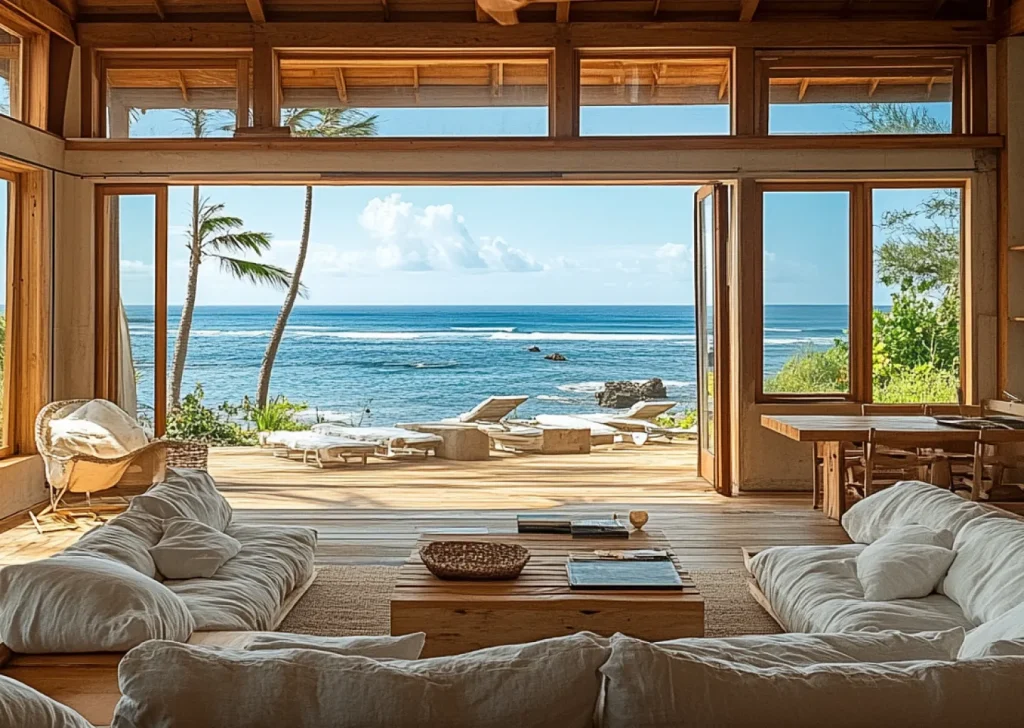As a Bali property owner, understanding the different types of vacation rentals is crucial for maximizing your income potential and attracting the right guests. From luxurious villas to cozy bungalows, each option has its pros and cons. Discover which one aligns with your investment goals and target market.
In this article, I’m going to cover these topics:
- Comprehensive overview of different vacation rental types
- Detailed comparison of villas and apartments
- In-depth analysis of target markets for each property type
- Key factors to consider before investing in Bali property
Find out which property could fit your investment portfolio best;
Types of Vacation Rentals
With so many types of vacation rental available, choosing the right one may feel overwhelming at first. In this article, we reveal their pros and cons, and offer tips that might be helpful for your investment or business decision.
Villas
Often associated with luxury vacation, villas are independent houses with private pools, gardens, and ample space. They are popular among families and groups of friends.
In a peaceful or tropical environment, villas are usually larger, standalone homes with lots of room and seclusion. It often includes world-class amenities such as private pools, breathtaking views, and spacious gardens. A villa’s luxury interior design may have numerous indoor and outdoor lounge areas, all of which embrace the surrounding landscape.
Target market: Luxury travelers, families, groups of friends.
| Benefits | Drawbacks |
|---|---|
| High rental yields due to premium pricing. | High initial investment and ongoing maintenance costs. |
| Potential for long-term rentals or off-season bookings. | Staffing requirements (e.g., cleaning, pool maintenance, gardening). |
| Strong demand from luxury travelers and families. | Potential for vacancy during low seasons. |
| Potential for additional income streams | Dependence on the high-end market. |
Apartments
Suitable for both short and long-term stays, apartments offer self-contained living spaces within a larger complex. They can range from studio apartments to multi-bedroom units.
An apartment is a convenient and affordable option for shorter vacations in cities or neighboring suburbs. You will often find these multi-family units within large complexes. They provide basic living amenities and a place to rest your head after a day of exploring. Apartments come in many styles, containing both luxury and budget-friendly vacation accommodations.
Target market: Couples, solo travelers, budget-conscious travelers, business travelers.
| Benefits | Drawbacks |
|---|---|
| Lower initial investment compared to villas. | Lower rental yields compared to villas. |
| Potential for higher occupancy rates due to a broader target market. | Potential for higher operating costs due to utilities and common area maintenance. |
| Opportunity for long-term rentals or student accommodation. | Competition from other apartment rentals. |
| Potential for capital appreciation in prime locations. | Dependence on short-term rental market fluctuations. |
Bungalows
Typically found in tropical locations like Bali, bungalows are smaller, often one-story structures with open-air designs. They offer a rustic charm and are popular among couples and solo travelers.
These accommodations offer a cozy, affordable option for couples or small families who want to share a small space. The simple layout with minimal living space encourages quality time together. You will often find bungalows in beach towns or scenic locations, providing a relaxing atmosphere close to nature.
Target market: Couples, solo travelers, honeymooners.
| Benefits | Drawbacks |
|---|---|
| Unique and charming aesthetic appeal. | Smaller size limits target market. |
| Strong demand from couples and honeymooners. | Potential for seasonality in demand. |
| Potential for higher occupancy rates during peak seasons. | Competition from other bungalow rentals. |
| Lower maintenance costs compared to villas. | Dependence on specific tourist preferences. |
Guest House
Smaller than villas but larger than apartments, guest houses provide a home-like atmosphere and often include shared amenities like a pool or garden.
Target market: Couples, solo travelers, budget-conscious travelers.
| Benefits | Drawbacks |
|---|---|
| Homely atmosphere can attract repeat guests. | Lower rental yields compared to other property types. |
| Potential for long-term rentals or student accommodation. | Increased management time due to personal involvement. |
| Lower initial investment compared to villas or apartments. | Potential for lower occupancy rates. |
| Opportunity to build personal relationships with guests. | Dependence on local market and word-of-mouth reputation. |
Beach House
Beach houses offer the quintessential coastal retreat, putting you steps away from the sand and surf. Imagine waking up to the sound of crashing waves, spending your days sunbathing and enjoying breathtaking sunrises or sunsets. A beach house is perfect for families with children or water enthusiasts who want to indulge in water sports like surfing, kayaking or paddle boarding.
Target market: Families, groups of friends, couples.
| Benefits | Drawbacks |
|---|---|
| High demand during peak seasons. | High initial investment due to prime location. |
| Potential for premium pricing due to location. | Vulnerability to natural disasters (e.g., storms, tsunamis). |
| Opportunity for additional income streams (e.g., beach equipment rentals). | Seasonal fluctuations in occupancy. |
| Strong appeal to families and groups of friends. | Dependence on beach-related tourism. |
Studio
Studios are compact living spaces with affordability as its biggest perk. They are often in prime urban locations that put you steps away from the action. Plus, with minimal cleaning required in a single space, travelers can maximize their time exploring a destination.
Target market: Solo travelers, couples, budget-conscious travelers.
| Benefits | Drawbacks |
|---|---|
| Low initial investment. | Lower rental yields compared to larger properties. |
| High occupancy rates due to affordability. | Limited space for amenities. |
| Suitable for various target markets (solo travelers, couples, budget-conscious). | Competition from other studios and hostels. |
| Flexible rental options (short-term, long-term, or student accommodation). | Dependence on short-term rental market fluctuations. |
Villas vs. Apartments: Detailed Comparisons
The most common vacation rental type in Bali is villas. However, apartments can be another investment option, especially if you are a beginner in this area.
Here are the comparison between these two types of vacation rental accommodation;
| Villas | Apartments |
|---|---|
| Standalone properties: Villas are independent houses, offering complete privacy and exclusivity. | Part of a complex: Apartments are individual units within a larger building or complex. |
| Spacious: They typically have larger living areas, multiple bedrooms, and private outdoor spaces like gardens or pools. | Shared amenities: Residents often share common areas like pools, gyms, and reception. |
| Luxury amenities: Villas often come with high-end amenities such as private pools, kitchens, and sometimes staff. | Smaller spaces: Generally, apartments have smaller living areas compared to villas. |
| Target market: Families, groups of friends, and luxury travelers are the primary target market. | Target market: Couples, solo travelers, and budget-conscious tourists. |
| Investment: Higher initial investment due to property purchase and maintenance costs. However, potential rental income is also typically higher. | Investment: Lower initial investment compared to villas. Rental income is typically lower, but operating costs might be lower as well. |
Key Considerations Before Investing in a Bali Property
Deciding on the right property type for your investment is crucial. Here are some key factors to consider:
Financial Factors
- Budget: Determine your total investment, including purchase price, renovation costs, and operational expenses.
- Return on Investment (ROI): Calculate potential rental income, expenses, and overall profitability.
- Cash Flow: Evaluate the property’s ability to generate positive cash flow.
- Financing Options: Explore mortgage availability, interest rates, and loan terms.
Market Analysis
- Location: Consider the property’s proximity to amenities, attractions, and target market.
- Competition: Analyze the local vacation rental market to identify opportunities and challenges.
- Demand: Assess seasonal fluctuations in tourist demand and occupancy rates.
- Rental Yields: Research average rental income and occupancy rates for similar properties.
Property-Specific Factors
- Property Condition: Evaluate the property’s condition and potential renovation costs.
- Legal and Regulatory Compliance: Understand zoning laws, building permits, and tax regulations.
- Maintenance and Management: Consider the ongoing costs and time commitment required.
- Risk Assessment: Evaluate potential risks such as natural disasters, economic downturns, and changes in tourism trends.
Personal Considerations
- Investment Goals: Define your investment objectives (e.g., cash flow, capital appreciation, diversification).
- Risk Tolerance: Assess your comfort level with investment risks.
- Time Commitment: Determine your ability to manage the property or hire a property manager.
- Long-Term Vision: Consider your plans for the property (e.g., retirement, inheritance).
- By carefully considering these factors, you can make an informed decision about the most suitable property type for your investment goals.
The Bottom Line
Selecting the ideal vacation rental type in Bali requires careful consideration of factors like investment budget, target market, location, and personal goals.
With a comprehensive understanding about the advantages and disadvantages of each option, you can make informed decisions to maximize your rental income and achieve your investment objectives.





